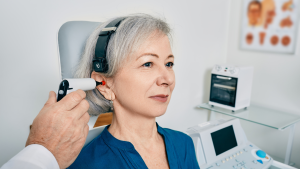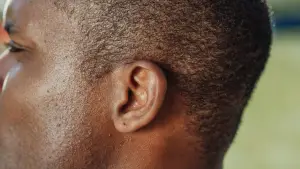Hearing aids have come a long way—literally and figuratively. What began as bulky, non-electronic amplifiers has transformed into sleek, AI-powered devices that fit discreetly in your ear and stream sound from your phone, TV, or even your doctor’s office. The journey of hearing aid technology mirrors the evolution of human innovation itself: a steady march from simplicity to sophistication, always aiming to improve how we connect with the world.
For millions of people with hearing loss, these advances have done more than enhance hearing—they’ve restored confidence, deepened relationships, and improved overall well-being. But how exactly did we get here? What key breakthroughs made today’s smart hearing aids possible?
In this guide, we’ll take a walk through time, exploring the most important milestones in hearing aid technology. From the simple ear trumpets of the 1800s to the AI-driven devices of today, this is a story of progress, persistence, and the pursuit of better hearing for all.
The Early Years: From Ear Trumpets to Vacuum Tubes (1800s–1940s)
Before microchips, Bluetooth, or even electricity, people with hearing loss relied on basic mechanical tools to amplify sound. These early solutions may seem primitive by today’s standards, but they laid the foundation for everything that followed.
Ear Trumpets and Acoustic Devices
In the 1800s, hearing support came in the form of ear trumpets—funnel-shaped devices that collected sound and directed it into the ear canal. Made from materials like metal, horn, or even wood, they were large, conspicuous, and lacked any amplification. They worked purely on acoustics, offering only limited improvement and requiring users to physically position the trumpet toward the sound source.
By the late 1800s and early 1900s, other devices like speaking tubes and acoustic chairs (yes, entire chairs designed to funnel sound!) were used, mostly among the wealthy. While clever, they were hardly practical or portable.
The Birth of Electronic Hearing Aids
The real breakthrough came with the invention of the carbon microphone in the early 1900s, which allowed sound to be converted into electrical signals. This led to the first electronic hearing aids—large, battery-powered units with wires connecting to a receiver worn on the body. Brands like Acousticon and Siemens began developing devices, but they were cumbersome and often required tabletop units.
Then came vacuum tube technology in the 1920s and 1930s, which made hearing aids slightly more portable. These devices used glass vacuum tubes to amplify sound and were powered by large batteries. While still bulky and worn on belts or in purses, they represented a major step forward in amplification power and sound quality.
Limitations of Early Designs
Despite their innovation, these early hearing aids had serious drawbacks:
- Size and weight made them impractical for many users
- Short battery life
- Poor sound fidelity, often distorting voices or amplifying background noise equally
- Social stigma, as their visibility made hearing loss more obvious
Still, for many, these devices were life-changing. They marked the beginning of a long journey toward making hearing accessible, effective, and discreet.
The Rise of Transistor Technology (1950s–1970s)
The 1950s ushered in a major turning point in hearing aid technology—the invention and adoption of the transistor. This tiny component replaced vacuum tubes and transformed hearing aids from bulky, body-worn devices into compact, wearable solutions. For the first time, hearing aids could be both powerful and portable.
What Made Transistors Revolutionary?
Transistors functioned as amplifiers and switches, just like vacuum tubes, but they were:
- Much smaller
- More energy-efficient
- More durable (no fragile glass tubes)
- Quieter and more stable, with less distortion
This allowed manufacturers to drastically shrink the size of hearing aids. Devices that once filled a purse could now fit behind the ear—or even in it.
The Era of Behind-the-Ear (BTE) Hearing Aids
With the development of smaller components, the behind-the-ear (BTE) style emerged and quickly became the standard. These devices housed the microphone and amplifier behind the ear, connected by a thin tube to an earpiece. Users appreciated:
- A less visible and more discreet design
- Improved comfort and wearability
- Greater amplification capabilities than ever before
Major manufacturers like Zenith, Beltone, and Oticon began mass-producing BTE models, making hearing aids more accessible and user-friendly.
In-the-Ear (ITE) Innovations
By the late 1960s and 1970s, further miniaturization led to the development of in-the-ear (ITE) hearing aids. These devices were custom-molded to fit inside the ear canal and were even less visible, appealing to users seeking a more cosmetic solution.
ITE models helped reduce social stigma and increased adoption among younger users and working adults who might have otherwise avoided hearing aids due to visibility concerns.
Limitations Remained
While transistors improved performance, hearing aids were still:
- Analog-only (amplifying all sounds equally)
- Lacking in feedback suppression or background noise filtering
- Dependent on manual volume controls
Despite these challenges, this era represented a leap forward. Hearing aids became lighter, more stylish, and more acceptable in public life. The path to personalized and adaptive hearing solutions was taking shape.
The Digital Revolution Begins (1980s–1990s)
As computers and microprocessors became more advanced in the 1980s, they sparked a groundbreaking shift in hearing aid design: the move from analog to digital processing. This transformation marked the beginning of the modern hearing aid era, offering users better sound clarity, more personalization, and less manual effort.
From Analog to Digital
Analog hearing aids amplify all sounds—speech, noise, and everything in between—equally. While effective, they often left users struggling in noisy environments.
Enter digital signal processing (DSP). This innovation allowed hearing aids to:
- Convert sound waves into digital signals
- Analyze and manipulate those signals in real time
- Deliver cleaner, more targeted amplification
The first fully digital hearing aid was introduced in the mid-1990s, and while it was expensive and limited at first, it quickly paved the way for widespread adoption.
Key Advancements in This Era
- Programmable Settings
Audiologists could now fine-tune hearing aids using computers, customizing amplification for different frequencies and environments. - Multiple Listening Programs
Users could switch between modes for quiet settings, noisy areas, or outdoor environments—enhancing adaptability. - Smaller and More Discreet Designs
Thanks to microchip technology, devices continued to shrink. Completely-in-the-canal (CIC) and invisible-in-canal (IIC) styles became more viable, offering near-invisible solutions. - Feedback Cancellation
Whistling and squealing—common complaints with analog aids—were greatly reduced through digital feedback suppression. - Noise Reduction Algorithms
Digital hearing aids began distinguishing between speech and noise, enhancing conversations in crowded places.
The User Experience Transformed
For the first time, hearing aids began to adjust to the user rather than the other way around. While early digital models came with a learning curve and higher cost, they set the stage for smarter, more intuitive devices that would follow in the 2000s.
This era also saw growing acceptance of hearing aids, as improved comfort, clarity, and customization encouraged more people—especially baby boomers—to seek treatment earlier.
Smart Hearing Aids and Wireless Connectivity (2000s–2010s)
The 2000s brought a wave of innovation that took hearing aids from simply amplifying sound to becoming smart, connected devices. Advances in wireless communication, mobile computing, and battery technology redefined what hearing aids could do—and how they fit into daily life.
Wireless Streaming and Connectivity
One of the biggest breakthroughs during this decade was Bluetooth® connectivity. Suddenly, hearing aids weren’t just for hearing people—they became portals to digital life.
- Phone calls, music, and GPS directions could be streamed directly to hearing aids
- Devices could pair with TV adapters, computers, and smartphones
- Hands-free calling and stereo-quality audio improved convenience and quality of life
These features gave users a more seamless and integrated experience, making hearing aids feel more like high-tech accessories than medical devices.
Smartphone Apps and Remote Control
Manufacturers began developing mobile apps that allowed users to:
- Adjust volume and program settings discreetly
- Monitor battery levels
- Track usage statistics
- Locate lost hearing aids
This was a major improvement for user autonomy, especially for tech-savvy individuals who wanted greater control over their hearing experience.
Improved Battery Technology
Battery life and management improved significantly:
- Zinc-air batteries became more reliable and longer-lasting
- Early models of rechargeable hearing aids began to emerge, though they were not yet widespread
These changes reduced the burden of frequent battery changes and made hearing aids more dependable.
Speech Processing and Directionality
More advanced speech enhancement algorithms were introduced, allowing hearing aids to:
- Better distinguish voices from background noise
- Focus on the direction of speech (e.g., someone in front of you)
- Reduce the fatigue associated with constant listening effort
This made social interactions, group conversations, and public outings much more enjoyable and less stressful.
A More Lifestyle-Friendly Device
During this time, hearing aids became:
- Smaller, with sleeker, ergonomic designs
- More discreet, fitting fully in the ear or hiding behind it
- Fashion-conscious, available in various colors and finishes
For many, hearing aids during the 2000s–2010s stopped being a symbol of aging and became a tool for empowerment—restoring confidence, independence, and connection.
AI, Rechargeables, and Self-Fitting Devices (2020s–Present)
In the 2020s, hearing aid technology has entered its most intelligent phase yet—defined by artificial intelligence (AI), rechargeable batteries, and greater user independence. These innovations are transforming hearing aids into smart health devices that do far more than amplify sound.
Artificial Intelligence and Machine Learning
Modern hearing aids now use AI algorithms to:
- Learn a user’s listening preferences over time
- Automatically adjust settings based on the sound environment
- Improve speech clarity in real-time, even in unpredictable noise
Some devices can distinguish between background chatter, wind, traffic, and music, fine-tuning the sound without the user lifting a finger.
AI has also enabled voice recognition, language translation, and fall detection in some premium models—blurring the line between hearing aids and wearable tech.
Rechargeable Batteries Become Standard
Rechargeability has become a default feature in most high-end models:
- Lithium-ion batteries last all day on a single charge
- Charging cases make recharging easy at home or on the go
- No more fiddling with tiny, disposable batteries
This is especially beneficial for older adults or those with dexterity challenges, improving convenience and sustainability.
Over-the-Counter (OTC) Hearing Aids
In 2022, the FDA approved over-the-counter hearing aids for adults with mild to moderate hearing loss. This landmark change has:
- Increased access and affordability
- Enabled more people to take early action
- Introduced a wave of consumer-facing brands and retailers into the hearing care space
OTC models often include self-fitting apps and online hearing tests, giving users more control—though professional guidance is still recommended for more complex needs.
Telehealth and Remote Fitting
The pandemic accelerated the growth of teleaudiology, allowing hearing care professionals to:
- Program and adjust hearing aids remotely
- Offer consultations via video call
- Provide real-time support without in-office visits
This has made hearing care more accessible to people in rural areas, those with mobility issues, or anyone seeking convenience.
Health-Tracking and Beyond
Some hearing aids now include:
- Heart rate monitoring
- Activity tracking
- Hearing loss alerts
- Integration with digital health apps
These features mark a shift toward holistic hearing healthcare, where hearing aids support both auditory and physical wellness.
What’s Next? The Future of Hearing Technology
As hearing aids continue to evolve, the future promises even more personalized, powerful, and multifunctional devices. Advances in neuroscience, biotechnology, and wearable tech are poised to redefine what hearing aids can do—and how they impact our lives.
Brain-Computer Integration
Researchers are exploring how hearing aids might connect directly with the brain’s auditory processing centers. Brain-computer interfaces (BCIs) could allow future devices to:
- Detect what the user is trying to focus on
- Adapt to changing environments with zero delay
- Improve cognitive support for those with memory loss or dementia
This could dramatically enhance speech understanding in complex settings like group conversations or noisy environments.
Biometric Monitoring
Hearing aids may become health monitors, not just hearing devices. Potential features include:
- Blood pressure tracking
- Body temperature monitoring
- Real-time heart rhythm detection
- Fall prediction and prevention tools
This could position hearing aids alongside smartwatches and fitness trackers as essential tools for aging in place and preventive health.
Smarter Self-Fitting Technology
AI-powered hearing tests and automated fitting algorithms are already improving. In the future, self-fitting devices may become so accurate that they rival professional fittings—especially with the help of machine learning and user feedback data.
This trend could further reduce costs and expand access for underserved communities.
Augmented Reality and Enhanced Audio Experiences
Imagine hearing aids that not only amplify sound but enhance your surroundings:
- Overlaying visual cues with auditory information via AR glasses
- Boosting speech clarity while filtering out unwanted noise like a zoom lens for sound
- Providing language translation or real-time transcription
These possibilities would make hearing aids invaluable even for people without hearing loss—potentially broadening their appeal.
Greater Integration with Everyday Tech
We can also expect hearing aids to integrate even more deeply with our digital lives:
- Seamless switching between devices (TV, phone, laptop)
- Smart home voice assistant compatibility (e.g., Alexa, Siri)
- Voice-based control and AI assistants embedded in the hearing aid
As technology becomes more intuitive and user-friendly, hearing aids will become more than just a tool—they’ll be an indispensable part of modern living.
Conclusion
From the humble ear trumpet to today’s sleek, AI-powered devices, the evolution of hearing aid technology is a story of remarkable innovation. Each decade has brought breakthroughs that not only improved sound quality but also reshaped how people with hearing loss interact with the world.
What was once a bulky, stigmatized necessity is now a discreet, powerful tool that enhances communication, supports wellness, and connects users to their digital lives. Whether you’re considering hearing aids for the first time or you’re a seasoned user interested in the latest features, understanding this history helps you appreciate just how far the technology has come—and what incredible possibilities lie ahead.
The future of hearing aids is not just about better hearing—it’s about better living. By staying informed and embracing new advances, you can take control of your hearing health and enjoy richer, more connected experiences at every stage of life.
FAQ
When were hearing aids first invented?
The earliest forms of hearing aids date back to the 1600s with basic ear trumpets. However, the first electronic hearing aids emerged in the early 1900s with carbon microphone technology. The major turning point came in the 1950s with the introduction of transistors, allowing for smaller, more practical designs.
What is the biggest recent breakthrough in hearing aid technology?
The integration of artificial intelligence (AI) and Bluetooth connectivity are two of the most significant recent advancements. AI enables real-time sound optimization, while Bluetooth allows users to stream audio directly from phones, TVs, and other devices.
Are over-the-counter (OTC) hearing aids effective?
OTC hearing aids can be effective for adults with mild to moderate hearing loss. They offer more affordable, accessible solutions, though they lack the personalized programming that professional devices offer. For complex hearing needs, a professionally fitted device is usually recommended.
Do hearing aids now include health tracking?
Yes. Some modern hearing aids offer fitness tracking, heart rate monitoring, and even fall detection. These features are part of a growing trend toward integrating hearing aids with overall health and wellness technology.
Will hearing aids keep getting smaller?
While many are already nearly invisible, future innovations may focus more on functionality and integration than just miniaturization. That said, new materials and design techniques continue to push the boundaries of discretion and comfort.
This article is for informational purposes only and is not a substitute for professional medical advice, diagnosis, or treatment. If you are concerned about your hearing or ear health, please consult a qualified healthcare provider.






